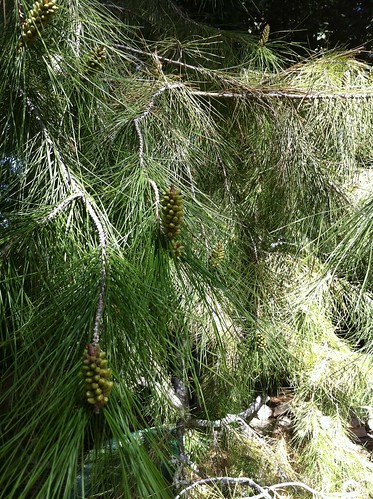
This Garden Vocabulary series seeks to introduce and explain to you — and in many cases, myself — words and terms associated with gardening. Please let me know if there are any terms you would like me to explore. You can leave your ideas in the comments section and we can learn together!
Conifer
“The conifers, division Pinophyta, also known as division Coniferophyta or Coniferae, are one of 13 or 14 division level taxa within the Kingdom Plantae. Pinophytes are gymnosperms. They are cone-bearing seed plants with vascular tissue; all extant conifers are woody plants, the great majority being trees with just a few being shrubs. Typical examples of conifers include cedars, Douglas-firs, cypresses, firs, junipers, kauri, larches, pines, hemlocks, redwoods, spruces, and yews.[1]
Read the entire article on Wikipedia, Pinophyta (Conifer), http://en.wikipedia.org/wiki/Conifer
I never knew that confreres was such a diverse set up trees and shrubs. Wikipedia redirect conifers to an entry on Pinophyta, a large division in the new scientific naming system that, frankly, is a bit confusing to me. I think I will have to study up on the International Code of Nomenclature for algae, fungi, and plants (ICN). It has changed greatly (not just in name, either) over the years since I was in college. I always just considered conifers the opposite of deciduous trees, but there is so much differentiation between the various types of conifers. There are several different types of leaves in the confer family including needle0like, awl-like and scale-like. After seeing some of the examples in the Wikipedia article, I realize I have seen many of these types, but never really thought about how much the conifers differ while still being the same.

Photo: Douglas E. Welch
For my own part, I love conifers of all types. The smell , the sound of the wind in their needles and the lovely bark have always attracted me. I distinctly remember a State Park we often visited, Findlay State Park in Ohio, that had several large groves of pines. In the hot Summer it was always much cooler under its branches and you were simply overwhelmed with the pine smell.
I recently lost several pines here in my own garden to drought and beetle, but I still have a cedar and a large redwood that I hope to keep for a long time to come. I’ll be covering the redwood in an upcoming entry in my Garden Inventory series. Watch the blog for more information.
Video from YouTube User Larry Nau
Further reading on Conifer:
- American Conifer Society
- Conifer Society Videos on YouTube
- Tree Identification – The Conifers: A Guide for North American Softwood Tree Identification
- How to prune conifers from Fine Gardening
Previously on Garden Vocabulary: